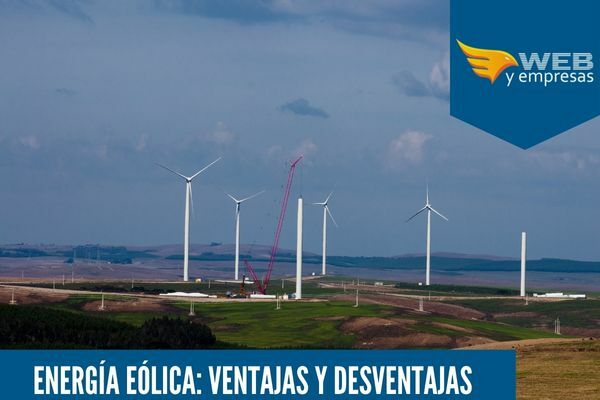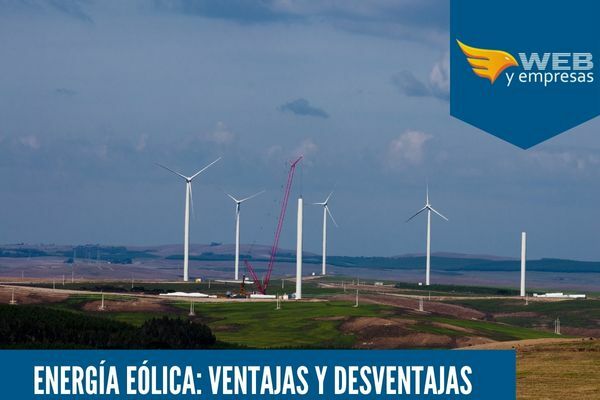The wind power is a renewable energy which has become a hope for sustainable energy production, taking advantage of the inexhaustible wind force to supply electricity to the population.

Advertisements
Being this, together with solar energy, the most used renewable energies in the world, this has great advantages, although it also has disadvantages, such as those described in the following table:
| Advantages | Disadvantages |
| It is a renewable and inexhaustible energy. | It requires large initial investments. |
| It does not generate pollutants. | It interferes with the flight paths of birds. |
| Contributes to energy independence and security | Open spaces are needed to generate power on a large scale. |
| Create jobs. | It depends on the weather conditions. |
| Better use of the land. | Generates visual impact on the landscape. |
| Promote technological developments. | It is not storable. |
| Does not require mining. | It is not constant. |
| Low maintenance cost. | It requires specialized personnel for its installation and maintenance. |
Advertisements
As seen in the table, wind power has advantages and disadvantages, however, its advantages outweigh its disadvantages; To better understand what this wind energy is all about, let's define its concept, operation and delve a little more into its pros and cons.
In this article you will find:
What is eolic energy?
Wind power is a type of energy that is obtained from the force in the movement of the wind, that is, its kinetic energy, which is used to generate electricity, through electrical generating equipment.
Advertisements
This kind of energy is renewable, which can be freely consumed without running out; In addition, during its transformation process does not generate toxic gases greenhouse effect, such as CO₂, or other pollutants, being considered a clean energy source.
How does wind energy work?
Energy solar is produced through wind turbines, which take advantage of the kinetic energy of the wind, to generate mechanical energy and transform it into electrical energy.
Advertisements
The process It starts when the wind spins the huge blades or propellers of the wind turbine rotor., through a rotation system with a mechanical transmission, within the same wind turbine a gearbox increases the rotation speed from 30 (rpm) revolutions per minute to 1500 (rpm), which is then transformed into electricity by a generator, and through an electrical regulation system, it is distributed to the electricity grid for consumption.
8 Advantages and Disadvantages of Wind Power
As we mentioned before, wind energy has great advantages and disadvantages, however, its great potential compared to its disadvantages makes this an excellent alternative energy to reduce the consumption of source energy fossil.
Advertisements
Let's see what they are about:
8 advantages
It is a renewable and inexhaustible energy: Wind currents can be generated without running out, in such a way that it can be used without consumption limits, making it, In addition to renewable, a sustainable energy that can be used without jeopardizing the availability of this resource in future generations.
Does not generate pollutants: Wind energy is a highly clean energy, since wind turbines do not generate gas emissions or other waste that can harm the environment, a situation that, if it occurs with fuels of easy origin such as coal, natural gas and Petroleum.
Contributes to energy independence and security: Wind energy is an excellent alternative to reduce energy dependence on other countries, contributing to the national production of energy through autochthonous sources, in turn improving the energy security of the country in a way sustainable.
Create sources of work: Wind power plants provide a large number of sources of employment, from specialized direct labor for installation and maintenance of wind turbines, such as biologists, lawyers, workers in charge of maintaining the surface of fields or wind farms, among others.
Better use of land: The wind turbines have a high vertical design to be able to take advantage of the wind currents in a more efficient way, this allows it not to be occupied such a large area of land, making it compatible with agricultural and livestock activities that can be established without problem on the same surface as the wind farm.
Promotes technological developments: The great potential of wind energy means that every day it seeks to generate new innovations at a global level. technology, to make the wind turbines more efficient in the production of electrical energy from of the wind.
Does not require mining: One of the advantages of this energy is that, by taking advantage of the force of the wind, it does not require the exploitation of energy minerals from the earth, such as oil, coal, natural gas, uranium, among others.
Low maintenance cost: Wind turbines are relatively inexpensive to maintain compared to their volume of power production, making this a very cost-effective power source with a long useful life.
8 Disadvantages
Requires strong initial investments: Both the wind turbines and the electricity grid for their distribution have a high cost, and if you want to use energy on a large scale, you need several wind turbines.
They also require investing in previous studies to determine the ideal place for the installation of the wind turbines, through wind assessments to estimate its potential as a source of wind energy, in addition to procedures and permits legal.
Interferes with the flight paths of birds: This is one of its great disadvantages, since they affect the flight of birds that often collide and lose their lives, product of the speed with which the propellers rotate in the rotors of the wind turbines; being forced to leave their natural habitat.
Open spaces are needed to generate power on a large scale: Well, it is necessary that the wind currents flow freely without anything interfering, from this depends on its ability to move the propellers in the rotors, and with it the generation of energy.
Depends on weather conditions: Wind power, like solar energy, depends on the weather conditions, there are times of the year when the wind travels at a greater speed than others, and its direction can also change, making it difficult to pinpoint the energy at produce.
Generates visual impact on the landscape: The wind farms, although for some it is very entertaining to see, the truth is that it deteriorates the natural landscape, since the wind towers can measure more than 150 meters high, with huge rotating propellers of up to 40 meters that can be observed from a long distance, which is often a bit annoying for the population local.
It is not storable: This is one of its great disadvantages, since the electrical energy produced needs to be consumed immediately, since it cannot be stored, it is distributed directly in the electrical grid, making it necessary to use other complementary energy sources for seasons of low energy efficiency wind.
It is not constant: Wind energy is not constant, as it has to depend on natural factors such as the weather, since, in order for it to work optimally, gusts of wind must travel between 10 and 40 km/h.
Hence, the fields or wind farms are not only installed in places with strong winds, but also that these prevail most of the year.
It requires specialized personnel for its installation and maintenance: Although it does not require constant maintenance once installed, it does require periodic preventive maintenance, as well as maintenance corrective measures to guarantee its optimal operation, for this a team of engineers specialized in this type of structures.


